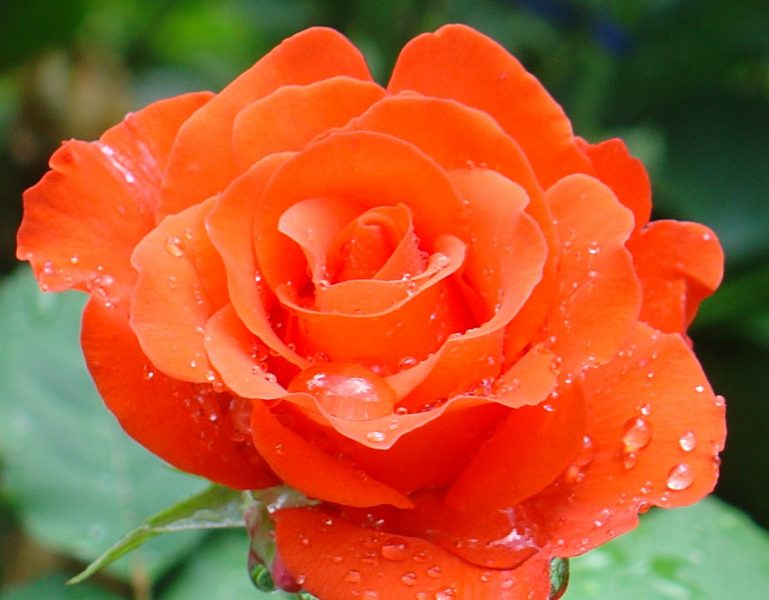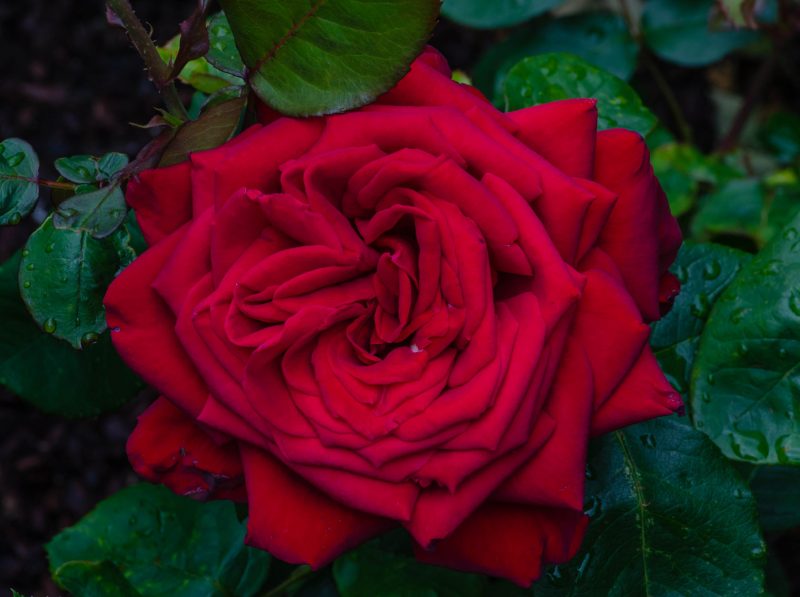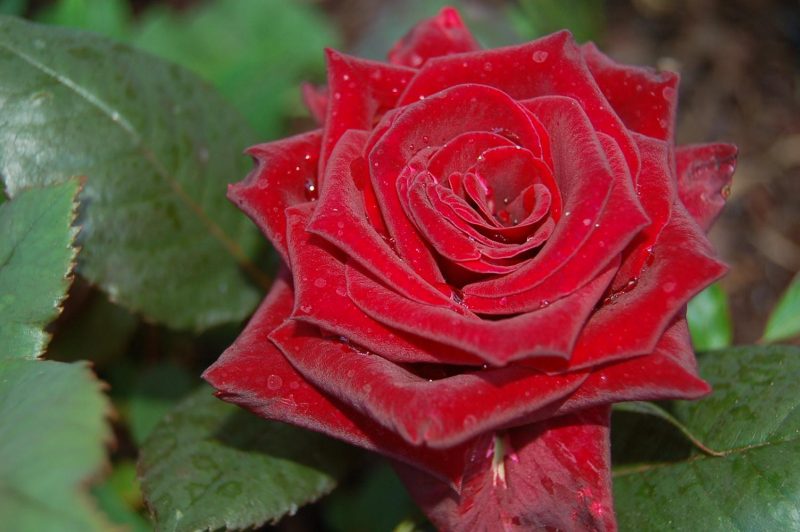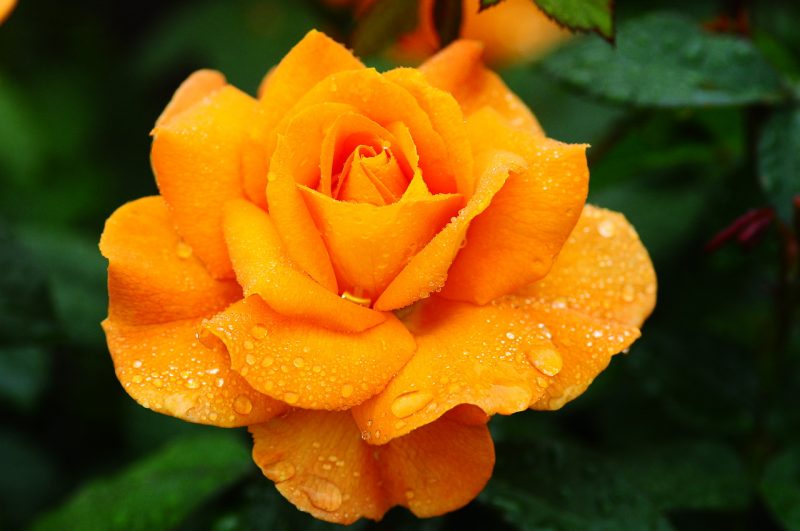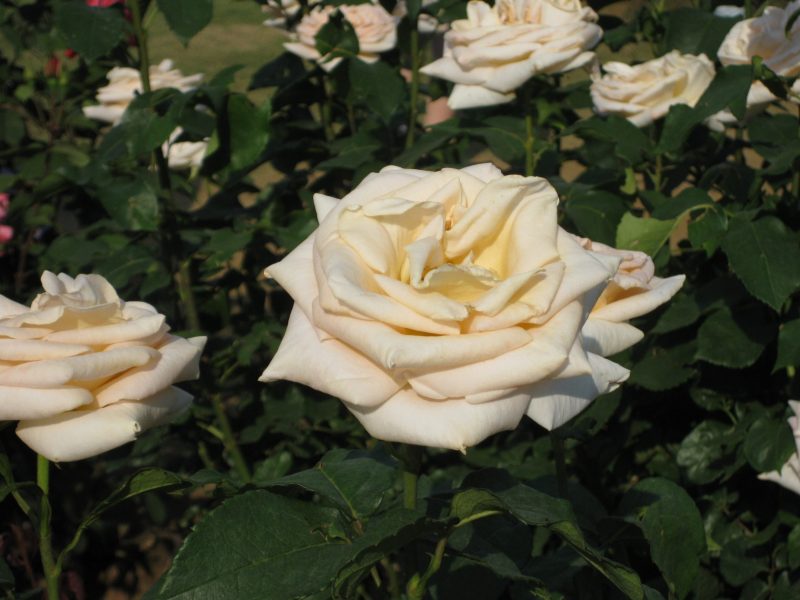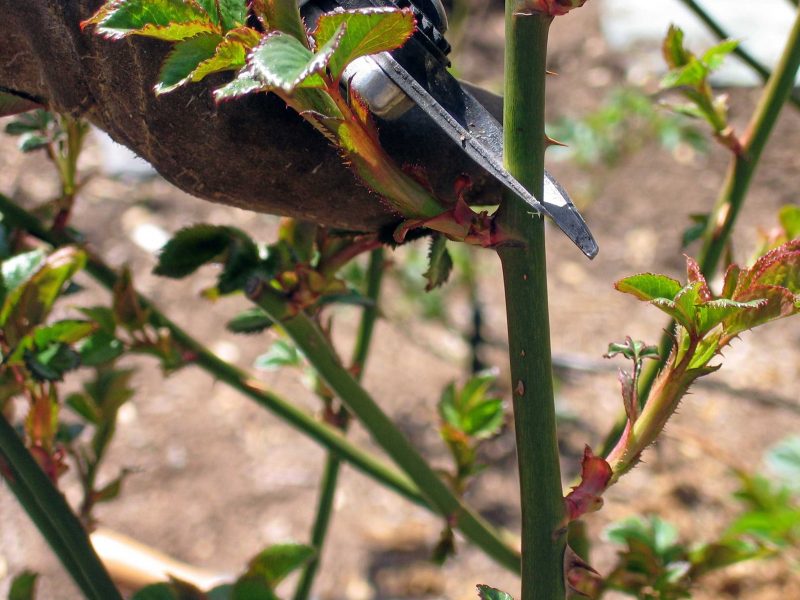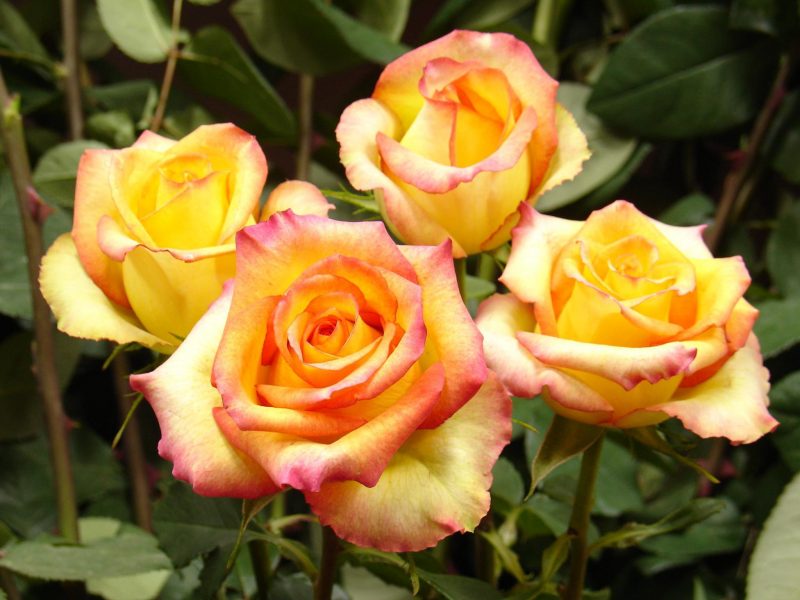Hybrid tea rose obtained by crossing tea and remontant roses. From the first she inherited a long, plentiful and aromatic flowering, from the second - resistance to adverse environmental factors and diseases.
Material Content:
Description of Tea Hybrid Roses
The group of tea hybrid roses looks very diverse, but all its representatives have a number of common features:
- erect branching shoots of various (from 50 to 200 cm) heights;
- dense glossy or opaque leaves of a saturated green shade;
- large, from 7 to 12 cm in diameter, single or collected in racemose buds, painted in various shades;
- spectacular long (from June to the first frost) and plentiful flowering.
Numerous tea rose hybrids not only decorate gardens and parks, but are also cultivated on an industrial scale for cutting.
Variety of varieties and species
The line of tea hybrids has about 10,000 varieties, differing:
- shoot height;
- the shape of the bush;
- the structure and colors of the buds;
- the strength of aroma;
- features of vegetation.
The variety of rose species has given rise to several classifications. One of them is based on the dominant color of the buds. According to this characteristic, all varieties of tea-hybrid roses are divided into groups.
Hybrids of maroon shades
The catalog of such varieties is one of the most numerous.
Among the representatives of the group are both long-known and classic plant species, as well as new, most recently obtained:
- Monica variety combines roses with straight tall (up to 1 m) shoots, almost devoid of thorns, and large (10–13 cm in diameter) buds that glow against a background of dark green foliage. Rosa Monica is resistant to disease and tolerate frosts well.
- The description of Black Baccarat variety fits into one phrase - this is the darkest of the red, black roses.
Extraordinarily beautiful varieties of light red, scarlet and pink shades:
- The world-famous type of Nostalgia plant with fragile elegant buds, the core of which is painted in cream tones and surrounded by cherry-colored petals with wavy edges.
- The pale pink hybrids of Lolita Lempika are amazing with an abundance of buds: up to 40 pieces on one bush.
Some representatives of the red group have a double color with a contrasting or smooth transition of tones, the presence of edging or krap.
Yellow orange varieties
Hybrids of yellow and orange types of roses are characterized by variability of aroma and shades of buds as they bloom:
- Doris Tisterman - the upper part of the petals of this variety is orange, the bottom is raspberry. Depending on the composition of the soil and lighting, shades can vary from light peach to saturated tangerines.
- High Magic is an unpretentious and disease-resistant hybrid with a conical glass of bud, shape and color (orange with a smooth transition to red), resembling a flame.
- Gloria Day is a variety known by several names (Xi Si, Meyyan) and origin, shrouded in legends. Appreciated for its wonderful appearance and delicate aroma of large buds with pale yellow petals in a raspberry frame.
The variability of the color of yellow roses contributed to the consolidation of the significance of separation and betrayal. Current trends have left this archaism. Today, yellow roses are a symbol of success, radiance and happiness.
White and cream hybrids
Admiration for perfection causes contemplation of these delightful roses, represented by a large number of varieties:
- Evening Star, large (8-10 cm) single buds of plants of this hybrid consist of spiral-lobed petals.
- Avalange, famous for its snow-white, with a slight emerald tint, flowers exuding a delicate sweet aroma. With all its fragile beauty, this is one of the most unpretentious and disease-resistant variety.
- The roses of Bagatelle Gardens are distinguished by large (10-12 cm) buds formed by petals with a light creamy upper part and a peach lower one.
A group of hybrids of white roses is complemented by varieties with white, casting pink, purple and purple shades of petals.
Varieties of lilac and lilac shades
As you know, blue roses do not exist, but breeders have already received hybrids painted in lilac tones:
- Blue Moon roses stand out with delicate light lilac buds that exude a strong aroma.
- Paradise hybrid flowers are painted in lavender with a light silver tint and bordered with a thin red edging. As it unfolds, the color of the petals becomes more saturated, the edging is wide and bright raspberry.
Most varieties of tea hybrid roses are widely cultivated, but among them there are quite rare varieties that are grown only for exhibitions.
Basic soil requirements
Hybrid tea roses develop well on nutritious, sour, loose or drained lands.
Most varieties prefer sunny places protected from winds and drafts.
Planting roses in the open ground
In southern Russia, roses are planted in autumn, in September. Before the cold weather, plants have time to root and get stronger. In the central part of Russia, it is preferable to plant a rose in spring in the soil, which has warmed up to 8–10 ° C.
Planting tea hybrid roses is carried out after preparatory work:
- For 1-2 weeks on the selected site digging pits, the size of which is determined:
- the volume of the root system of the seedling;
- the need to add a nutrient layer (on poor soils up to 50 cm);
- deepening the site of inoculation or the root neck of the seedling.
2.A few hours (from 3 to 12) before planting, the roots of the plant are immersed in water with the addition of any growth stimulator (Kornevin, potassium humate).
Read also:root application instructions
3. At the bottom of the pit, the nutrient mixture is poured:
- ½ buckets of humus, humus or well (at least 3 years) rotted manure;
- a glass of ash;
- about 30 g nitroammophoski;
- about 1/2 bucket of topsoil soil.
All components are thoroughly mixed. The roots of a seedling are shortened by a centimeter, which is important for the development of lateral branches that increase the suction surface.
After that proceed directly to the landing:
- In the central part of the recess, a slight elevation is made on which the plant is placed. The roots should lie freely without bending up, the stump (the place of vaccination) is directed to the south.
- The plant is covered with ordinary garden soil, buried on sandy soils by 8-12 cm, on clay soils - from 3 to 5 cm.
Deepening contributes to the formation of new shoots from the scion, and not the stock, which is the wild rose, and also protects the plant from freezing and aging.
After planting, a small depression is built around the shoots to retain moisture, the soil is abundantly (10 l per bush) moistened. Long thick branches shorten secateurs to 3-5, thin - up to 2-3 kidneys. The slice is carried out at an acute angle 1.5–2 cm above the kidney and closed with garden var.
The nuances of growing and caring for a hybrid tea rose
Hybrid tea roses need competent and systematic care, consisting in watering, fertilizing, pruning and preventative treatments against pests and diseases. Each of these events has nuances that determine their effectiveness.
Watering is a mandatory procedure, the regularity of which is determined by the vegetative state of roses:
- in spring, during an active increase in ground mass and before buds are formed, they are watered frequently (at least 1 time in 7 days) and abundantly;
- moisten the soil under flowering plants once every 1.5–2 weeks;
- after flowering, in autumn, watered only in case of prolonged absence of rainfall.
Humidification is arranged by rain or standing water, heated in the sun, which is poured under the root, trying to avoid moisture on the leaves and buds. After watering, trunks circles are mulched with humus.
Feeding begins in the second year.
Fertilizers are applied several times per season, alternating the use of mineral additives and organics:
- In the spring, nitrogen mixtures are introduced. For example, a solution prepared on the basis of 10 l of water, 10 g of urea and 15–20 g of nitrate. After 1-1.5 weeks, top dressing is repeated using organics. Around the shoots lay up to 5 liters of mullein and loosen it with the ground. After top dressing, the plant is watered abundantly.
- During budding, roses are fertilized with infused for 2 weeks and diluted 1.5 times with chicken manure solution (1 liter per 8 liters of liquid).
- After the first wave of flowering, phosphorus-potassium mineral additives (superphosphate - 30–45 g per bush or 10 l of water) are added in dry or liquid form.
- The last top dressing is carried out in autumn, pouring 1 liter of a liquid mixture under each bush containing 25 g of superphosphate, 10 g of potassium sulfate, 2.5 g of boric acid, dissolved in 10 l of water.
Regular watering and properly organized feeding is the key to the abundant and bright flowering of tea-hybrid roses.
Cropping and preparing for the winter
Hybrid tea roses are pruned 3 times:
- in early spring, when the buds swell to 0.5–0.6 cm, the shoots are shortened by more than half, leaving 3-4 buds on each;
- in summer, removing wilted buds along with the upper part of the shoots, which increases the abundance of the second flowering wave;
- in the fall, in preparation for winter, pruning and burning all broken, damaged and very weak (unripe) shoots. Long branches shorten up to 6 buds.
After the last pruning, the bushes for the winter are covered with dry leaves or spruce branches and covered with a layer (25 cm) of peat.In areas with frosty winters, an additional frame is made of insulation material.
Disease and Pest Control
Hybrid tea roses are prone to powdery mildew. To prevent the development of the disease, preventive treatment with a solution of soda (40 g / 1 liter of water) will help from the moment the leaves appear and until flowering. Events are held 2 times a week.
Juices of rose leaves love to enjoy caterpillars, leafworms, aphids and spider mites. If single lesions are detected, insects are removed manually using a soft cloth dipped in soapy water. In case of severe damage, insecticides (Actellic, Green Shield for roses, Rose Savior, Augustine "Biotlin") and acaricides (Kleschevit, Antiklesh) are used.
It is interesting:Actellik - instruction
In gratitude for the correct landing and proper care, tea-hybrid roses will delight those around with their magnificent flowers until the first frost.



